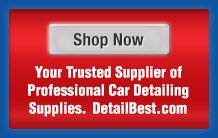Still have Car Detailing Questions? HELP IS ON THE WAY!
Send
us an E-mail if you have any detailing questions, or still need to know
more about Zymol. We have a variety of experts in our corner ready to
help you! We'll be posting a selection of questions and answers here
regularly.
Q. Zymol is made in Germany, isn’t it?
A. No, the Zymol hand crafted products are made in Connecticut. Some contracted products are made in other US locations.
Q. How do I get wax off of rubber trim?
A. Try some natural peanut butter (the kind where the oil and peanut butter are separated). You can celebrate your accomplishment with a nice peanut butter & jelly sandwich afterwards.:-)
Q. WHY IS EVERYONE CRAZY ABOUT CLAY BARS?
A. Detailing clay bars are sweeping the car care industry and fans by storm! The secret of the pro detailers is now out, and for good reason.
This Japanese invention was designed to remove overspray and minor flaws at auto body shops. Before that, abrasive rubbing compounds were the only solution, and not a very preferable one.
WHAT IS CLAY?
Clay bars can be natural or synthetic, but most manufacturers produce synthetic clay bars. The Zymol Lehm Klay is natural, and contains naturally derived Kaolin clay from Africa. It is user friendly and the finest that we know of.
WHAT DOES A CLAY BAR DO?
The bars will snatch the tiniest of debris and hold onto it as it glides across the paint. Used with a proper lubricant such as Lehm Lube, clay bars are not abrasive and will not affect the paint surface with the exception of cleaning it. Anything that protrudes above the top coat surface will be grabbed by the clay bar and pulled out. The lubricant will prevent this debris from scratching the vehicle. Once clayed, the paint will feel remarkably smooth and have an impressively clean shine!
Clay pulls out things you don’t readily notice, like pollution damage and brake dust. Though you may not see the deposits, the surface can feel bumpy or grimy and they may cause patches of paint to appear dull, even after waxing.
Glass is also affected by the same environmental pollutants as the paint. Use clay to clean these surfaces, too. It will not scratch metal or glass!
Clay bars also easily removes tar, sap, overspray, and tree gum. It’s much safer than corrosive spot cleaners and it leaves the surface incredibly smooth.
WHAT IS THE PURPOSE OF THE CLAY LUBRICANT?
Detailng using the Lehm Klay lubricant is essential to the performance and safety of clay. It provides the necessary slick surface for clay to glide on. Beware of soapy water as a clay lube because some detergents will cause the clay to deteriorate. Soapy water here isn’t worth the gamble. Stick with a genuine clay lubricant to get the best performance and longevity from your detailing clay. Lehm Lube at $15. is inexpensive insurance.
Our sales of Zymol Lehm Klay are growing exponentially, and sometimes these items are back-ordered. But it’s always worth the slight wait if this the case.
Q. My car is loaded with swirl marks on the paintwork. Even a lot of exotic show cars I’ve seen have them. What should I do?
A. Try a treatment (maybe a few time) of Zymol HD-Cleanse. If this doesn’t do it your car may be a candidate for professional paintwork correction. You will need a highly experienced auto body technician for this. Look for examples of completed work and recommendations from owners of higher line concours cars. Ask on the detailing discussion boards. Your neighbor who just got a good deal from the discount store on the power buffer is not your candidate of choice!
Every time you engage in "paintwork correction" clearcoat and even paint is being REMOVED from your car. Don't go to this well too often.
Be patient when searching for the right shop. Your search could even take you hundreds of miles, but the trouble is well worth it!
Q. MY OWNER'S MANUAL SAYS THAT I SHOULDN'T USE WAXES THAT BEAD WATER EXCESSIVELY. WHAT COULD POSSIBLY BE THE REASON FOR THAT?
A. Here's the answer to your wax question via our auto body consultant.
The reason you are told to avoid waxes that "bead water excessively" like a good wax should is that it is felt by some parties that water droplets act like thousands of magnifying glasses damaging your paintwork.
You may safely assume that he does not agree with the official "recommendation".
However, if you don't wax, first the clearcoat comes off, then the paint oxidizes. Result= Even more DAMAGED PAINTWORK! Then paint FAILURE!
Since I do believe that you are intelligent enough to dry your car after washing it, I see no problem. When you drive a waxed car, water will come off anyway. Actually, much easier than an unwaxed car!
Keep sending those questions! Visit the Detailbest store for the “contact us” link.
